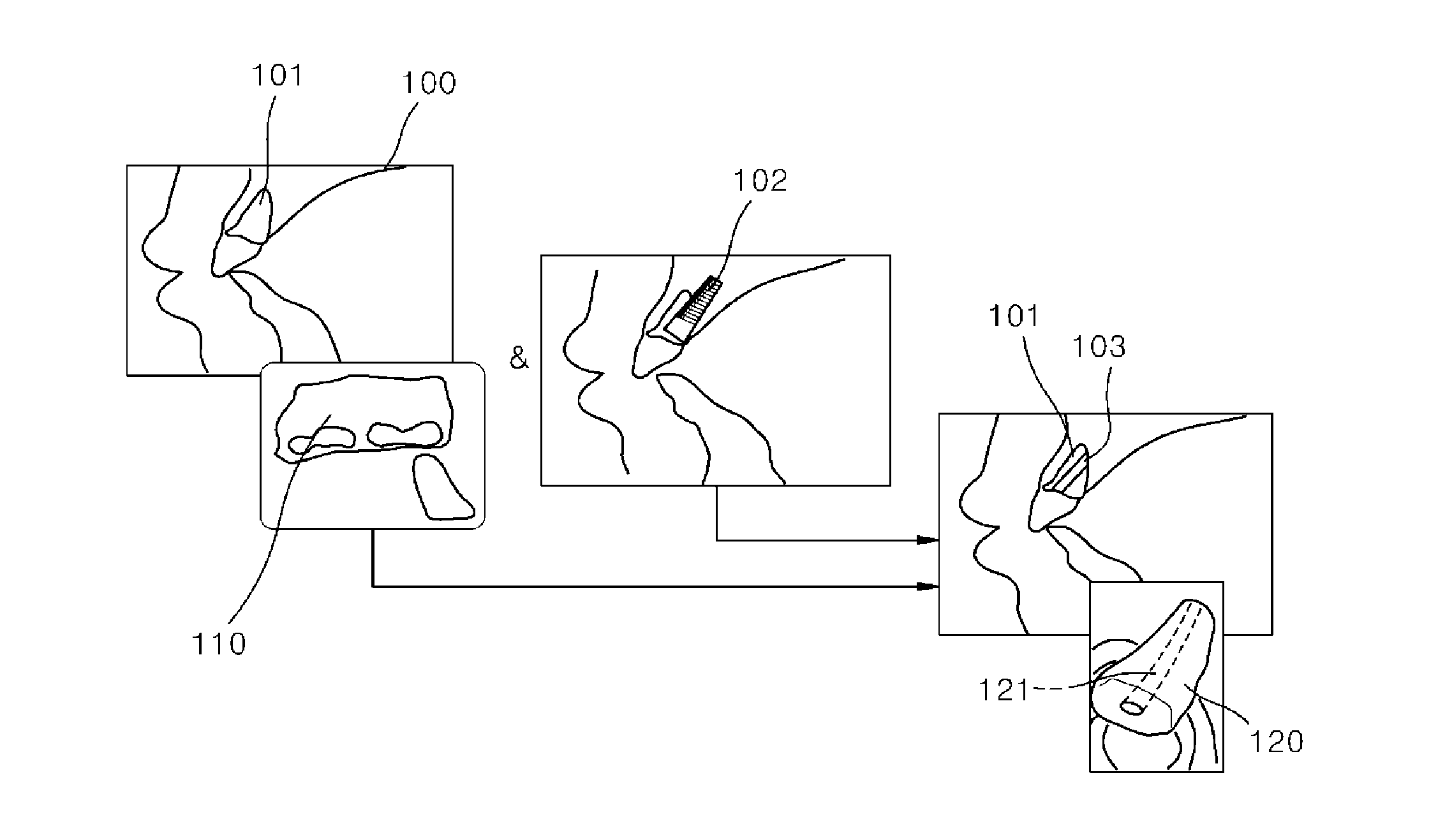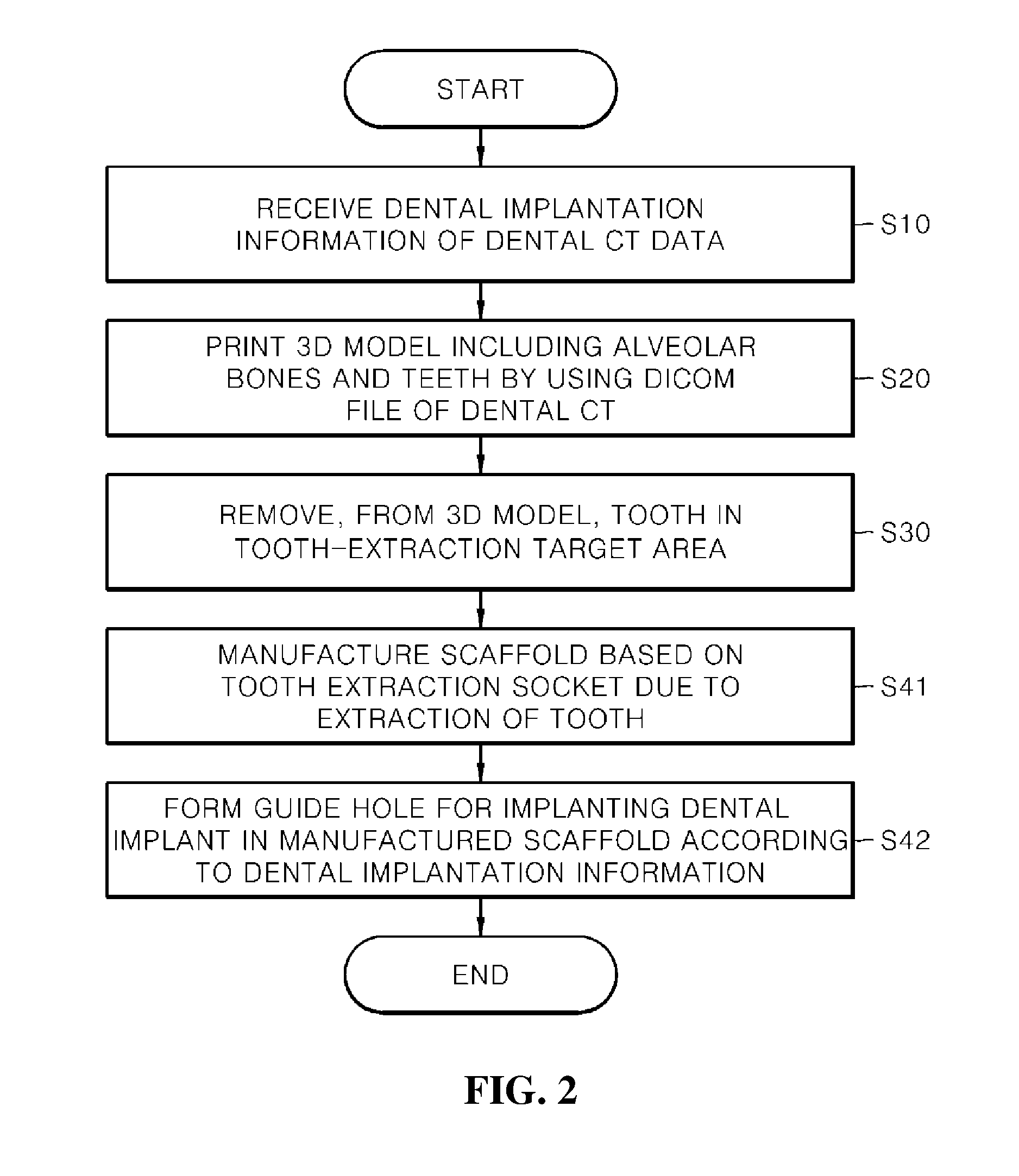Method of manufacturing scaffold for treatment of tooth extraction socket and implantation of dental implant
- Summary
- Abstract
- Description
- Claims
- Application Information
AI Technical Summary
Benefits of technology
Problems solved by technology
Method used
Image
Examples
first embodiment
[0008]According to the present disclosure, there is provided a method of manufacturing a scaffold for treatment of a tooth extraction socket and implantation of a dental implant, the method including receiving dental implantation information of dental CT data which is previously input via a terminal of a manager; manufacturing, by using a three-dimensional (3D) printer, a 3D model including alveolar bones and teeth, which are distinguished therebetween, based on a medical image file that is a medical image file (DICOM file) of the dental CT data; performing virtual tooth-extraction by removing, from the manufactured 3D model, a region corresponding to a tooth in a tooth-extraction target area; and manufacturing, by using the 3D printer, a scaffold to be placed in an actual tooth extraction socket according to a shape of a tooth extraction socket that exists in the manufactured 3D model as a result of the virtual tooth-extraction, wherein, when the scaffold is manufactured, image dat...
second embodiment
[0009]According to the present disclosure, there is provided a method of manufacturing a scaffold for treatment of a tooth extraction socket and implantation of a dental implant, the method including: receiving dental implantation information of dental CT data which is previously input via a terminal of a manager; manufacturing, by using a three-dimensional (3D) printer, a 3D model including alveolar bones and teeth, which are distinguished therebetween, based on a medical image file that is a medical image file (DICOM file) of the dental CT data; performing virtual tooth-extraction by removing, from the manufactured 3D model, a region corresponding to a tooth in a tooth-extraction target area; manufacturing, by using the 3D printer, a scaffold to be placed in an actual tooth extraction socket according to a shape of a tooth extraction socket that exists in the manufactured 3D model as a result of the virtual tooth-extraction; and forming a guide hole for implanting the dental impla...
third embodiment
[0010]According to the present disclosure, there is provided a method of manufacturing a scaffold for treatment of a tooth extraction socket and implantation of a dental implant, the method including receiving, from a computerized tomography (CT) imaging apparatus, a medical image file that is a medical image file (DICOM file) of dental CT data, and dental implantation information that is previously input via a terminal of a manager; generating image data of a scaffold to be placed in the tooth extraction socket formed when a tooth in a tooth-extraction target area is extracted, by using a region corresponding to the tooth in the tooth-extraction target area in the medical image file; amending the generated image data of the scaffold so as to allow a guide hole for implanting the dental implant to be formed in the scaffold, based on the dental implantation information;
[0011]and manufacturing a scaffold corresponding to the amended image data by using a three-dimensional (3D) printer...
PUM
| Property | Measurement | Unit |
|---|---|---|
| Angle | aaaaa | aaaaa |
Abstract
Description
Claims
Application Information
 Login to View More
Login to View More - R&D
- Intellectual Property
- Life Sciences
- Materials
- Tech Scout
- Unparalleled Data Quality
- Higher Quality Content
- 60% Fewer Hallucinations
Browse by: Latest US Patents, China's latest patents, Technical Efficacy Thesaurus, Application Domain, Technology Topic, Popular Technical Reports.
© 2025 PatSnap. All rights reserved.Legal|Privacy policy|Modern Slavery Act Transparency Statement|Sitemap|About US| Contact US: help@patsnap.com



